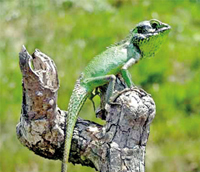
Former Customs official charges delay in CITES listing of endangered reptiles
A delay by the Department of Wildlife Conservation (DWC) to submit a proposal to include newly discovered endangered reptiles to the CITES list (Convention on International Trade of Endangered Species of Wild Fauna and Flora) is preventing international action against those smuggling reptile species out the country, a former Customs Deputy Director claimed.
Mr. Samantha Gunasekara, the founder of the Customs’ Biodiversity Protection Unit (BPU) told the Sunday Times that he provided the DWC a Scholarly Document requesting rare engendered reptile species be added to CITES ensuring that action could be taken internationally against those smuggling these species.
However, he said though he provided the document well ahead of time, the DWC provided the document to the Foreign Ministry only two days before the closing date.
Therefore the proposal could not be included before the 17th Meeting of the Conference of the Parties to CITES held at Johannesburg from September 24 to October 5. A delegation from Sri Lanka too participated in the convention and proposed the inclusion of Thresher Shark in the CITES list.
However, DWC Acting Director General W.S.K.Pathiratna said though he was unaware of any document being provided on proposing endangered Sri Lankan lizard species to be included in CITES, yet support for anyone who submits such a document would be given.
However, Mr. Gunasekara said the document was submitted through the Ministry to the Department, but the officials had taken up the position that there was no necessity to submit the document.
Mr. Gunasekara claimed at first a foreign scientist had provided the document to the DWC but due to lack of response it was forwarded to him.
Thereafter he had informed the minister in-charge of Wildlife Conservation and appointed a committee of foreign and local scientists who were willing to send a proposal to CITES free of charge.
“Meanwhile I investigated and learned that several organised groups were engaged in smuggling Sri Lankan endangered reptile species” he said.
He explained that he was unable to identify individuals but was able trace how the highly organised smugglers operated their multi-billion rupee business of capturing and exporting endangered and newly found rare species avoiding international detection by exporting reptiles not included in the CITES.
Mr. Gunasekara explained that many Sri Lankan gecko species, lizards and snakes are endemic and make rare exotic pets for which there is a high demand.
The trade is carried out in a process where experts pinpoint where the reptiles are found and inform a separate capture team to go to the selected region of the forest. Then they provide the transport to fly the animals abroad.
The CITES is an international document which covers endangered species in captivity and therefore is stronger than the Flora and Fauna Protection Ordinance which does not cover animals bred in captivity.
“The CITES protected species is an animal which has to be exported with a CITES document from the DWC and when the animal is internationally recognised as an endangered specimen Interpol, Customs and foreign countries can ban or place restrictions, or take legal action against the smugglers,” he said .
Fined for keeping endangered lizards
A businessman who was arrested during a raid by Department of Wildlife Conservation (DWC) officials for keeping 18 endangered Horned and Leaf-nosed Lizards was released on bail of Rs. 200,000 after being produced before the Negombo Additional Magistrate Kapila Dushayantha Epitawela.
He pleaded guilty to four offences including removing an animal from its natural environment and keeping animals illegally. The man was fined Rs. 50,000 for each offence
The man identified as Suren Cooray (41) was arrested at Kanuwana in the Ja Ela area by the DWC flying squad on a tip-off.
DWC Acting Director General W.S.K.Pathiratna said the man was engaged in the reptile smuggling racket and providing reptiles to foreign dealers.
“According the Wild Life Act it is illegal to capture, exhibit or rear wild life specimens mentioned in the Protected List. Even the remains of a dead specimen cannot be kept in custody,” he said.
Source : Sunday Times http://www.sundaytimes.lk/161009/news/former-customs-official-charges-delay-in-cites-listing-of-endangered-reptiles-211920.html
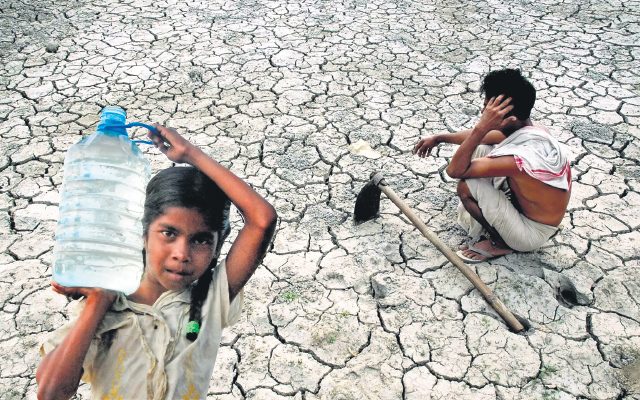
Climate change and its effect on agriculture
According to Disaster Management Centre data over 200,000 people have been affected by the recent drought. Among those who experience water shortage due to the drought are 69,678 people in Eastern Province, 8,600 people in Northern Province, 8,422 people in North Western Province, over 10,000 people in Sabaragamuwa Province and 110,350 people from 23,000 families in the North Central Province.
Kirama Oya and Kattakaduwa tanks in the southern part of Sri Lanka have almost run dry and the National Water Supply and Drainage Board is working to resolve the issue of salt water intrusion into the Kalu Ganga River.
Although the Water Board assures that water supply to Colombo will not be affected, those affected in the Northern Province, North Central Province, North Western Province and Sabaragamuwa Province will have to be provided with water bowsers.
Freak weather is an indicator of climate change. In fact, climate change is characterized by the rise in temperature, rising sea levels and extreme weather events such as droughts, floods, cyclones, landslides and issues such as salt water intrusion.
The global temperature is expected to rise 1.8 to 40 C by the end of the 21st Century.
Developing nations are considered more susceptible to climate change effects as economic constrains make it difficult for them to deal with the damages caused by climate change. They are also technologically less advanced and therefore lack access to adaptive technology.
Being a natural resource dependent production process, agriculture is the most vulnerable to climate change. For example farmers island-wide complain of the reduction in crops due to the prevailing drought. Janatha Vimukthi Peramuna (JVP) North Western Provincial Councillor and the National Organizer of the All Ceylon Peasants Federation, Namal Karunaratne said that farmers of vegetables such as radish, kohlrabi, chillies, beetroot and capsicum chillies – all of which require water twice a day – big onions, potato (solanum tuberosum), corn, cow pea, green gram, orid (undu), cucumber (pipigngna and kekiri), soya and fruits including water melon, banana and coconut were the worst affected.
Karunaratne noted that the cost of production is high owing to the fact that fertilizer and seeds are expensive while farmers must also bring in water from elsewhere.
“The cost of vegetables on the other hand has gone down”, he explained. “In the wells they have built to procure water for farming purposes, the water levels are low. In others, the mud and silt must be removed. Then, there are others who have dug wells near tanks and because they do not have electricity, they must use kerosene or diesel to power the motors of the water pumps. The cost of fuel is high. This still does not compensate for natural rain. These are additional costs they have to incur. This is unfair for the farmers”.
Sixty-six per cent of Sri Lankan cropland is rain-fed, making them most vulnerable to drought. Paddy, tea, spices and vegetable cultivation are affected by drought and delayed monsoonal rains.
Paddy specifically depends on water for most of its lifecycle. According to an exploratory study on adapting to climate change in coastal areas of Sri Lanka by Shanila Athulathmudali, et al, nearly 70 per cent of the paddy cultivated is in the dry zone which has an average annual rainfall of less than 1750 mm. Consequently, adaptive measures are vital when climate goes haywire.
On the other hand excess rainfall has an equally detrimental effect. For example 50 per cent of the cropland in four agricultural districts was inundated due to the January 2011 floods. Sea level rise does not only affect fisheries, it also affects agricultural practices in the interior as salt water intrudes into internal water bodies on which cultivations depend for irrigation. Whichever climatic extreme prevails, agricultural productivity suffers.
Smallholder farmers of developing nations will, thus, have to bear the brunt of climate change effects. Smallholder farmers are especially at risk as income generated through agriculture is their only source of sustenance. Climate change effects heighten poverty levels in the rural agriculture sector, which will further impede climate adaptation measures making them increasingly vulnerable to climate variability, which in turn further reduces agricultural productivity, further increasing poverty. This is a vicious cycle. Consequently climate change adaptation is vital for the protection of those engaged in agriculture as well as for food security in general.
Adaptation strategies
According to IPCC Fourth Assessment Report 2007, adaptation is the adjustment in natural or human systems in response to actual or expected climatic stimuli or their effects, which moderates harm or exploits beneficial opportunities.
Research such as Agricultural adaptation to climate change: insights from a farming community in Sri Lanka by Esham Mohamed and Chris Garforth have identified different types of adaptation. Introducing improved crop varieties, micro irrigation, reduction of irrigation depth and crop diversification are among the major adaptation strategies. Adopted measures at farm scale are crop, land, irrigation management and income diversification (Mohamed and Garforth, 2013). Crop management techniques such as changing crop variety, using mulches, changing planting time to suit rainfall variability, changing crop type to suit prevailing climate, shortening of growing season, planting shade trees and crop rotation are autonomous adaptive techniques employed at farm level in Sri Lanka.
The objective of adaptation strategies such as changing planting time, shortening of growing season, changing crop type and crop rotation is to ensure that critical growth periods do not overlap with dry spells. In fact, Mohamed and Garforth note that most Sri Lankan farmers opt for short-term paddy to overcome water shortage due to delayed monsoons. Farmers employ water and soil conservation techniques such as using crop residue as mulches and planting shade trees to reduce soil moisture loss. Mohamed and Garforth have observed that more farmers are reverting to traditional farming practices such as direct seeding to minimize water usage. Cultivation of alternate crops during dry spells has become the norm.
Water management adaptive systems include; increased use of supplementary irrigation, water conservation, rain water harvesting and using ground water. Adaptive land management techniques include soil conservation techniques, reduced tillage and deep ploughing and shifting cultivation. Income diversification techniques include off-farm employment. In an exploratory study on adapting to climate change in coastal areas of Sri Lanka, Shanila Athulathmudali observes that current adaptive practices are undertaken as a supplementary income. For example, saline resistant crops are grown on degraded land and sold at premium prices in niche markets. This is an additional income to their traditional paddy cultivation.
Genetically refined seed varieties developed by the Rice Research and Development Institute (RRDI) are a prime example for planned adaptation. Athulathmudali points out that genetically modified rice varieties that could tolerate unfavourable and problematic soil conditions such as iron toxicity, salinity, acid sulphate, low temperature, flood and drought situations could help increase productivity.
“The total cultivation area under these conditions is estimated to be around 30 per cent of the total rice lands in the country and their present yield levels range between 2 to 2.5t/ha,” Athulathmudali has noted.
Government institutions are responsible for the development and dissemination of new agriculture technology. Alleviating the pressure of climate change by rehabilitating minor tanks and providing fertilizer is another essential aspect of climate adaptation, according to Athulathmudali.
A sustainable agricultural policy is an essential climate change adaptation strategy. The Sri Lankan agricultural policy acknowledges and promotes the need to address sustainable principles as; increasing productivity of water and land by enhancing crop production through the application of sustainable cultivation practices; cultivating crops based on agro-climatic conditions and promoting agro-based industries; promoting production and utilization of organic and bio-fertilizers to gradually reduce the use of chemical fertilizers through Integrated Plant Nutrition Systems (IPNS); encouraging the use of efficient water management and moisture retention techniques to achieve high productivity in agriculture; conserving existing water resources for sustainable agricultural development; improving efficiency of rain-fed agriculture through water harvesting, mulching; promoting participatory irrigation management in maintaining and improving irrigation and drainage systems; promoting conservation of rain water and ground water; increasing water-use efficiency and promoting modern and intensive irrigation technologies for water conservation; promoting land conservation within watershed areas; strengthening rural credit institutions connected with farmers’ investments, savings and risk management and introducing appropriate agricultural insurance schemes to protect the farmers from the risks associated with natural calamities. (Source: Ministry of Agriculture 2009-2010, online.)
Obstacles to adaptation
Achieving afore-mentioned policy objectives is easier said than done. For example promoting production and utilization of organic and bio-fertilizers to gradually reduce the use of chemical fertilizers through Integrated Plant Nutrition Systems (IPNS), is difficult to achieve when the government is forced to subsidize fertilizer, just because scrapping the subsidy would be political suicide. Farmers are not inclined to switch to organic and bio-fertilizers when chemical fertilizer is low cost and easy to use.
Likewise promoting land conservation within watershed areas is difficult when such areas are denuded for agriculture itself. Take for example potato cultivation in the hill country that had not only removed tree cover but had also affected the soil quality. Introducing insurance schemes to protect the farmers from climate change related risks has proven difficult due to lack of enthusiasm of farmers. Crop insurance lacks wide acceptance among farmers in Sri Lanka, according to Mohamed and Garforth.
Farmers’ decisions to adapt depend on the constraints to adapt and their perceptions of climate change and applicability of adaptation methods at farm level. Understanding this is vital to developing adaptation strategies.
According to Mohamed and Garforth, inability of natural systems to adapt to the rate and magnitude of climate change and external factors such as economic constraints and technological backwardness are major obstacles to implementing climate change adaptation. In the Sri Lankan setting, lack of understanding on climate change, behavioural, social and cultural constraints are also barriers to introducing adaptive methodology. Lack of conducive socio-economic conditions such as assets, wealth and livelihood security, vital for decision-making can be major obstacles for climate change adaptation.
Most Sri Lankan farmers lack the financial means to engage in rainwater harvesting although such an adaptive method could have helped them to become more resilient to climate change. Traditional Sri Lankan farmers are often reluctant to change their traditional farming techniques and are often pessimistic about the effectiveness of adaptive techniques. The reason maybe lack of access to climate information such as weather forecasts and technological backwardness.
This goes to show that all these obstacles are inter-related and should be dealt with in parallel, in order to encourage adaptive techniques. Lack of policy intervention and lack of enthusiasm on the part of farmers to abide by sustainable policy is another impediment. But grassroots level adaptation can only go so far. Lack of governance structures, existing structures de-prioritizing climate change issues and not integrating climate change into development planning and implementation impedes climate change adaptation at institutional level.
Source :08/10/2016 The Nation http://nation.lk/online/2016/10/08/climate-change-and-its-effect-on-agriculture.html
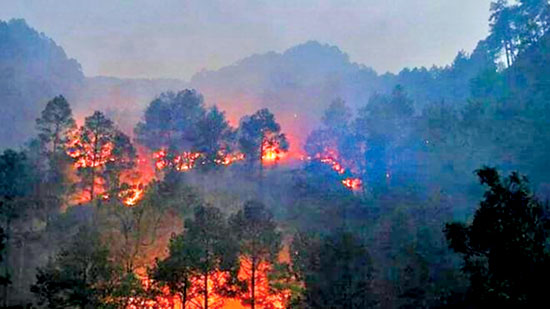
How humans burn Nature
The forest fires that heated the country recently has caused severe impacts on the irrigation system.
Aranda Edirisuriya President of Elahera Farmers’ Association said, even if a small part of the Knuckles Mountain range is set on fire, it could impact on the irrigation system in the Polonnaruwa District.
Agriculture industry, directly depending on the irrigation system, in Minneriya, Elahera, Girithale, and Kanthale areas are heavily affected when the water level reduces due to fires in the hill country.
“The moment the springs dry up in the Knuckles, the water level reduces, and farmers are forced to rely on the Mahaweli River for irrigation, which is not the usual practice, as it is difficult to manoeuver water to paddy fields.
Water for daily use has become a problem as well,” Edirisuriya said, adding that not only paddy fields, other cultivations too require constant watering.
Meanwhile, Conservator General of Forests Anura Sathurusinghe estimated that up to now 4,300 acres of forests have been destroyed due to forest fires, all of which are man-made. It is a much higher figure compared to last year, which was around 3,000 acres. “The higher damage could be attributed to the unusually dry weather this year, while the dry atmosphere, dry wind and dry trees act as fuel to the fires,” he said.
(Massive fl ame with a single match, a heavy toll on the Knuckles forest)
Illegal activities
Sathurusinghe claimed that most of the fires originated due to illegal activities, such as hunting and illegal breweries amid forests, than the clearing of forests for chena cultivation.
He admitted that the only preventive method available is to raise awareness among the public, and increase community participation in protecting the environment and keeping the forest department officials informed of any illegal activities.
“The public should be aware that a simple action such as throwing away a match without putting out the fire, could cause massive fires,” he said.
Admitting that these fires are a common occurrence during the dry season, Herath M. Dissanayake, former government servant and a farmer in Polonnaruwa said, there isn’t any awareness program on fire prevention.
“It’s of no use conducting awareness programs after a fire has happened. Ideally, awareness programs should be held twice a year or so, before the droughts, to inform the people of the risks of throwing cigarette butts in the forest, or matches which are lit. At present, no awareness or a sense of security is being discussed at community level”, he explained.
Young men
These are not organized crimes, or, as portrayed often, hunters setting fire to the forest to chase away animals to make the hunt easy for them, he said, adding that they have witnessed groups of young men who go to the forest for a smoke or a drink, and after getting drunk, set the forest on fire.
“We’ve seen them rushing out of the forest, after setting fire, high on their own laughter.
They have no empathy or sympathy. These young men go to the forest in their cars or cycles. The older people hardly get involved in setting forests on fire. The dry climate and the dry wind spreads the fires fast, adding more fuel to the problem,” he said.
“The damage, environmental and otherwise, caused by these fire cannot be estimated,” Deputy Director of the Disaster Management Centre Pradeep Kodippili said. Once a fire has started to spread putting it out becomes a mission that involves the military as well.
“The army has been deployed to assist in putting out these fires for the past 4-5 years, and the air force is given the location of the fires to use helicopters to spray water on the affected areas,” he explained.
To hire a helicopter for an hour, the DMC has to pay Rs.2-3 laks, and in most cases, they focus on spraying water in nearby areas to stop the fire from spreading, rather than trying to stop the fire itself.
“It is difficult to get the assistance of the air force helicopters for every fire. So, whenever we get their assistance, we focus on minimizing damage to lives and property, as opposed to trying to put out the fire, while it spreads.”
Source: 09/10/2016: Sunday Observer; http://www.sundayobserver.lk/2016/10/09/fea07.asp

To get sand, they’ll even burn down a forest
Opportunists burning down our forests simply in order to collect sand cheaply are amongthes whose actions have caused about 4,570 acres of forest and scrub to go up in flames this year alone.
“They do this because when it rains after a fire, all the solid is washed down into the streams and rivers which makes it easier to collect sand,” Forest Conservation Department Director, Anura Sathurusinghe said.
“This causes water springs to dry up, injury and death to wild animals and completely destroys the natural processes of the environment,” he said.
Fires have been burning in Hambantota, Nuwara Eliya, the Knuckles Range Monaragala, Anuradhapura and Badulla, and Mr. Sathurusinghe said most of them have been set alight by sand miners, poachers and cattle-owners razing forest land for pasture for their herds are mainly responsible for the forest fires.
Environmentalists say it may take more than many decades to restore the balance in the environment, following the destruction of the forests.
The arson has also had a severe impact on crops. Cinnamon crops and chena cultivations have been completely destroyed.
The fires were worsening the already-high air pollution over Sri Lanka, while also destroying forest ecosystems and affecting nesting birds and other animals, environmentalist, Lahiru Supun Prakash of the Biodiversity Conservation and Research Circle said.
The burning down of trees, Mr. Prakash added, was also damaging the country’s ability to combat greenhouse gas emissions. Trees absorb and store carbon from the atmosphere, so the more trees that are burned the harder it becomes to combat climate change in the future.
“These fires are causing severe consequences to the environment. Important plants, waterways are destroyed. There is an increased risk of landslides, and they also have an adverse effect on weather patterns, causing droughts in the future,” Disaster Management Ministry Deputy Director, Sarath Lal Kumara said.
“We believe that the best way to tackle this problem is by creating awareness as many of the offenders go undetected while the police will not make any arrests without proof.”
But the thick smoke and remote and difficult, mountainous terrain were making the job difficult for firefighters, army soldiers and forest guards deployed to battle the flames, Mr. Kumara said adding that, nearby villagers have been asked to stay on alert but none has yet been asked to evacuate.
Arsonists can be fined up to Rs. 50,000 or be given a two to five-year sentence, Mr. Sathurusinghe said,
Mr. Prakash said it was fortunate that many of the fires are either in grassland areas or plantations of eucalyptus or pine so that the impact native forests and biodiversity was some on what limited.
Source : October,2016 Sunday Times http://www.sundaytimes.lk/161002/news/to-get-sand-theyll-even-burn-down-a-forest-211020.html
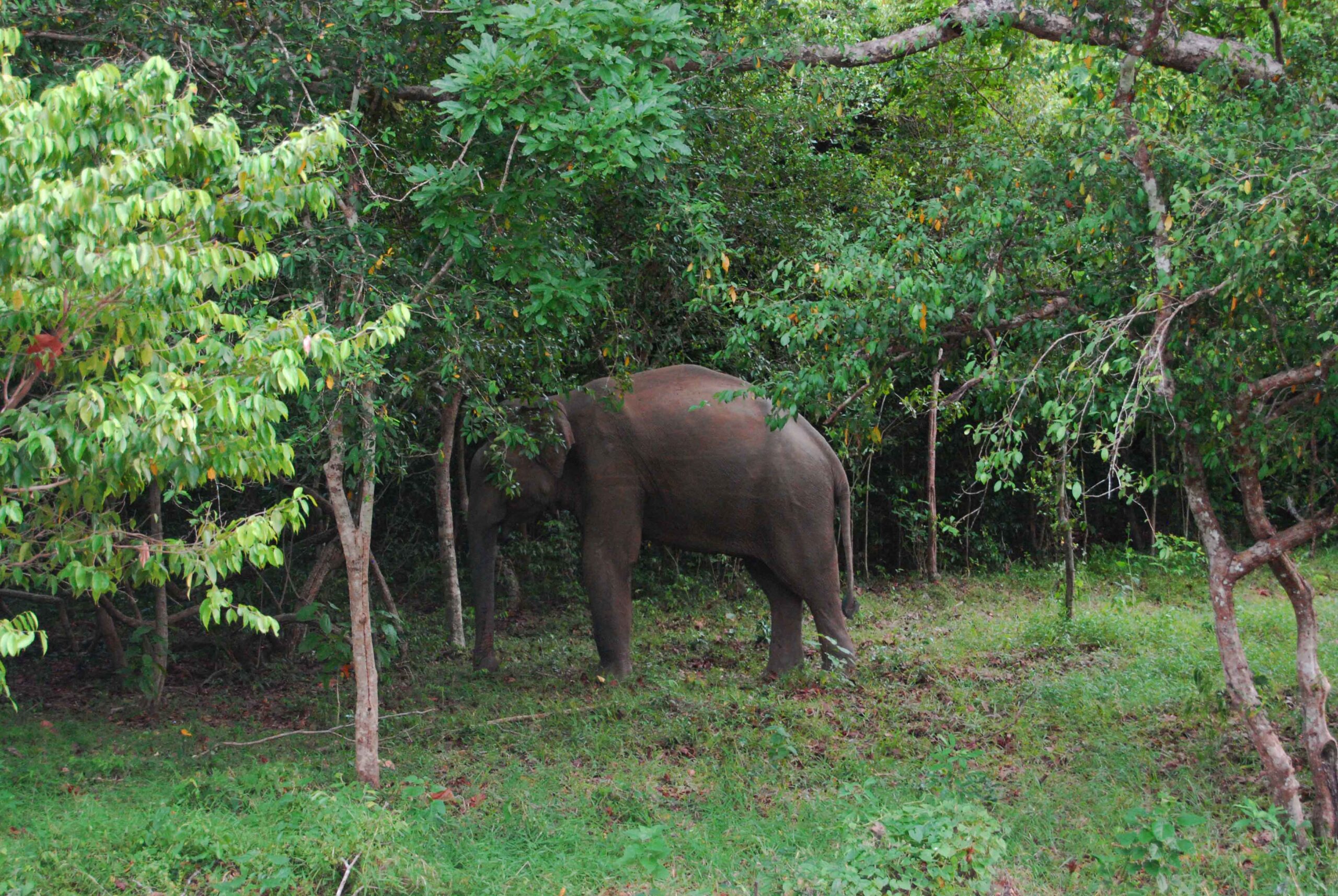
What price for Nature’s ‘greenbacks’ – the forests?
Conservationists are debating whether working out a rupee value for forests would convince money-crunching bureaucrats that preserving them makes more economic sense than stripping woodland for income-producing purposes.
“Many people consider forest as a waste of land where utilising that terrain for other purposes can bring income, also contributing to the national economy. But forests provide other services such as delivering the fresh water we drink and the clean air we breathe whereas if we lose these services it will cost a lot of money to implement costly alternatives,” the Conservator-General of Forests, Anura Sathurusinghe said.
“It is often a big challenge to communicate this value to politicians and officials who mainly understand the value of everything in monetary terms and demand forest land for other development work,” Mr. Sathurusinghe said at a press conference organised by REDD+ Sri Lanka regarding the forthcoming International Research Symposium on Valuation of Forest Ecosystems and Their Services to be held in Colombo on October 18.
REDD+ (Reducing Emissions from Deforestation and Forest Degradation) is an effort to identify value for the carbon stored in forests, offering incentives for developing countries.
“Tagging a value” for services provide by an ecosystem such as a forest is a modern concept. Ecosystem services are broadly divided into four categories: provisioning, such as the production of food and water; regulating, such as the control of climate and disease; supporting, such as nutrient cycles and crop pollination; cultural, such as spiritual and recreational benefits. The concept aims at putting a price tag for these services which helps to convey their values in monetary terms. Hence the price that has to be paid by destroying that particular forest is highlighted.
“We know about ‘provisioning’ values of forests such as the value of timber, but other services are often taken for granted,” said forests expert Professor Nimal Gunathilake. He explained the aims of the research forum were to share the existing knowledge on forest ecosystem services valuation, identifying new methodologies and identifying the drawbacks.

(Conservator General of Forests Anura Sathurusinghe)
Ecosystem valuation can be difficult and controversial, and economists have often been criticised for trying to place a “price tag” on nature. At the forum, a question was raised whether communicating the value of individual forests to the general public is prudent as people could start exploiting natural resources such as in the case of illegally stripping forests of “walla patta” trees and smuggling the resin-rich wood overseas.
Mr.Sathurusinghe revealed that a recent review of forests showed degradation was a bigger concern than deforestation. Deforestation means conversion of forest to another land use type while degradation is deterioration of the standing vegetation in density, structure and species composition due to human activities and natural causes.
The four main causes of deforestation are encroachment, infrastructure development projects and private agriculture ventures while drivers for forest degradation include illicit felling of trees, cattle grazing, forest fires, gem-mining, quarrying, forest undergrowth cultivations such as cardamom and non-timber forest product gathering such as weniwel or walla patta. A REDD+ Sri Lanka report states Anuradhapura is the district with the highest levels of deforestation and forest degradation.
Deforestation is taking place at a relatively higher rate in the dry zone due to the many development projects now occurring there. Experts cautioned that dry zone forests are as important as wet zone forests.
Source : October 2016 http://www.sundaytimes.lk/161002/news/what-price-for-natures-greenbacks-the-forests-211050.html
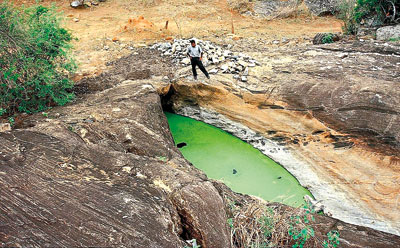
Animal fossils thousands of years old found in Yala
(The level of fossilisation indicates the animal bones are 1,000 to 5,000 years old. Pix by Rahul Samantha Hettiarachchi)
Bone fragments believed to be animals that died thousands of years ago were discovered from a rock pool in Yala this week.
They are parts of skeletons of elephants, tortoises, wild buffaloes, spotted deer, wild boar and other animals, say students of the Kelaniya University Postgraduate Institute of Archaeology who are studying the fossils.
The level of fossilisation indicates the animal bones are 1,000 to 5,000 years old, palaeobiodiversity expert Kelum Manamendra-arachchie said.
“Some of these bones could be older,” he added. With time, the organic materials inside bones are replaced by mineral substances and experts can estimate their age by observing the extent of this fossilisation process.
Fossilisation only happens in rare cases. Animal carcasses are usually eaten or bacteria can rots them away before fossilisation can occur.
Fossils are found when animals die in location where their carcasses – or parts of it – are protected from scavengers and the elements, such as when they are found on the seabed or a river bed and become buried in sand, soil or mud. Rock pools with beds of clayey mud are ideal, Mr. Manamendra-arachchie pointed out.
(Ther Thanamalwila rock pool)
The bones were found during efforts to find water sources for thirsty animals. Due to the drought, many of the Yala National Park’s waterholes have run dry. The Department of Wildlife Conservation (DWC) sent a crew with a backhoe to deepen a rock pool known as Wel-mal-kema in Yala Block I.
These rockpools are the lifeline of wild animals during droughts as many of them have water when other water sources run dry. It is believed animals became trapped in the mud of this rock pool when they came there for drinking water thousands of years ago.
Through analysis of the bones, Mr. Manamendra-arachchie is able to surmise that wild buffaloes were plentiful thousands of years ago in Yala. The national park has a population of wild buffaloes but these are mixed with domesticated buffaloes. Mr. Manamendra-arachchie says the base of the hobes are thicker in wild buffaloes and there were many such skulls among the excavated bones.
This Wel-mal-kema is 30 feet long and believed to be 30 ft deep. Only half of it has been excavated and it is possible that there could be much older fossils.
Yala has a number of such rock pools, so there could be many mysteries waiting to be unearthed. The Director-General of the DWC and the Minister for Wildlife has requested the Institute of Archaeology to continue with this study in Yala.
Mr. Manamendra-arachchie said he analysed a similar, but smaller rock pool in 2005 in Thanamalwila from which he collected four truckloads of bones that, he believes clearly accounted for more than 100 elephants, 150 wild buffaloes, 200 spotted deer, 150 wild boar and 50 sambhur deer. Most of them had almost become fossilised.
Source : October 2016-Sundaytimes ; http://www.sundaytimes.lk/161002/news/animal-fossils-thousands-of-years-old-found-in-yala-211131.html

Toyota’s environmental initiatives save 67mn tons of CO2 released to atmosphere
Making itself a set of six environmental challenges to be achieved by 2050, a pioneer in the eco-friendly hybrid vehicle technology, Toyota has managed to save 67 million tons of carbon dioxide (CO2) being released to the atmosphere through vehicle emission for the past two decades.
Since the launch of the world’s first mass-produced hybrid vehicle with the Toyota Prius in 1997 and up to May 2016, Toyota has sold over nine million hybrid vehicles showcasing its environmental initiatives across all aspects of business.
As the automaker behind the world’s first hybrid vehicle, this initiative had managed to save 25 million kiloliters of gasoline being burnt and emitting 67 million tons of CO2 released to the atmosphere. It would have needed about 22,000 sq km of rain forest to absorb the amount of CO2 if released to the environment.
Toyota believes that tackling the issue of carbon emissions related to vehicles is a shared responsibility between governments, automakers and road users, which requires continued collaboration.
The automobile giant recently announced in Japan that its approach is to continually improve its technologies to reduce CO2 emissions at all stages of the vehicle lifecycle, including development and design, production, logistics and sales.
At the development and design stage, Toyota takes a two-pronged approach to reduce fossil fuel consumption as this is crucial to reducing CO2 emissions. This is done through introducing fuelefficient vehicles such as hybrid vehicles and the development of vehicles that use alternative energy sources such as fuel cell vehicles and electric vehicles.
Toyota’s research into such environmentally friendly vehicles dates back to 1968 when Toyota first started development of a hybrid system. Among the advanced features of Toyota’s hybrid vehicles is Toyota Hybrid Synergy Drive, an intelligent system which can seamlessly switch between the electric motor and petrol engine or run off the combined power of both, depending on the driving conditions.
For environmentally friendly cars to contribute to the environment, Toyota recognizes that the use of environmentally friendly vehicles needs to increase as a proportion of all vehicles sold. To further promote their adoption, Toyota offers a continually expanding line-up of hybrid vehicles in every vehicle segment from compact passenger cars to SUVS and commercial vehicles. Toyota also recognizes that for hybrids to increase in popularity, they need to be as reliable as conventional vehicles. To address this, Toyota places a strong emphasis on its hybrid batteries which are used to power the electric motor components of these vehicles. Its batteries are manufactured by Primearth EV Energy, a company that conducts various endurance and reliability lab tests on the batteries to ensure quality.
Hybrid technology is also the base technology for vehicles that use alternative energy sources such as plugin hybrids, electric vehicles and fuel cell vehicles which Toyota has been developing in line with its approach to offer vehicles of diverse energy sources.
Source : 07-10-2016 Daily Mirror











